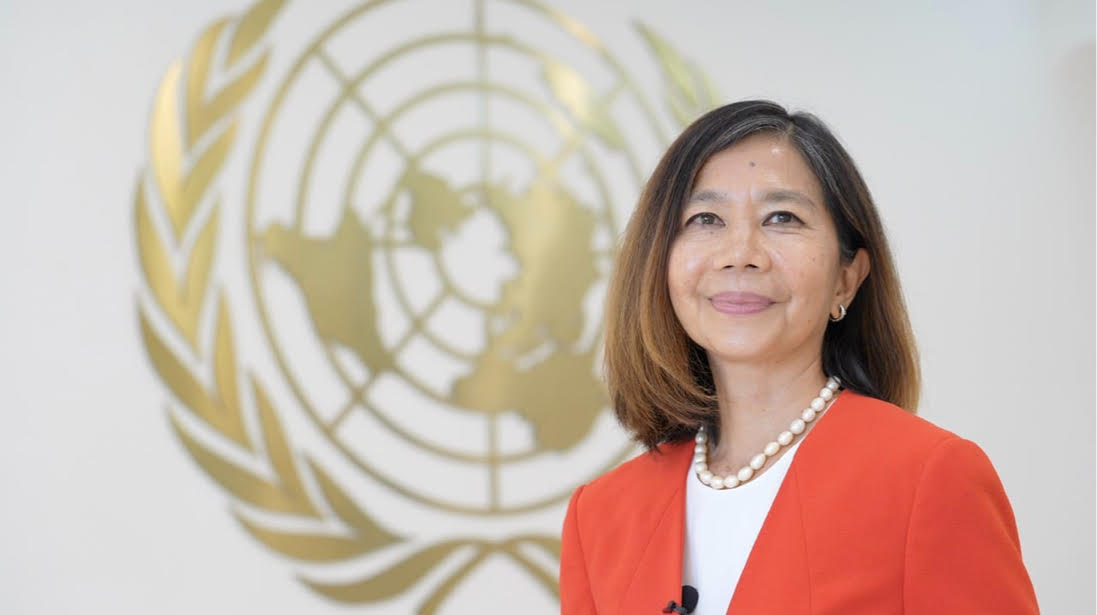Editor’s note: This story is written by Pauline Tamesis, Resident Coordinator of UN in Vietnam, and Caroline Nyamayemombe, Representative of UN Women in Vietnam, on the occasion of International Women’s Day 2024.
Le Thi Ha Giang, a young entrepreneur, is working hard to integrate digital skills in her business to keep up with the transforming society. As one of the 60 trainees of the Empower Her Tech Program by the United Nations Development Program, she learnt website building, digital design, using generative AI, and other digital skills which will help her grow her business in the future.
Mi has never felt this confident or respected in her life – she is now the main breadwinner in the family, despite having fallen victim to human trafficking. It became possible with the help of the International Organization on Migration, with support from the UK government and collaboratively with reintegration partners from the Vietnamese labor ministry, who provided Mi with three female goats – a source of food and additional income – and facilitated her societal reintegration.
These stories demonstrate that women, given the opportunity, are eager to work hard to change their lives for the better.
Vietnam has made strides in women’s empowerment. Legislation, including the Gender Equality Law and a special 35-percent candidate quota for women in the National Assembly, enabled the legal and policy environment to drive investments for women’s empowerment.
Efforts are showing results with the country climbing 11 places on the latest World Economic Forum’s Global Gender Gap Index, rising from 83rd to 72nd place out of 146 countries. Vietnam, with an over-70-percent female workforce participation rate, counts as one of the highest in the world, and with a 30.26-percent women representation in parliament, Vietnam exceeds the global average of 25.5 percent.
Nevertheless, like elsewhere in the world, women still face barriers to equal opportunities in education, employment, and access to leadership positions.
Ethnic minorities and disabled women especially stand out. Females from ethnic minorities represent only six percent and 7.3 percent of the membership of Party bodies and People’s Councils, respectively, compared to male ethnic minority cadres at 36.1 percent and 39 percent.
While Vietnam is on a good track at other levels, more work is needed at the commune level where women make up merely 22 percent of People’s Committee members.
|
|
| Caroline Nyamayemombe, Representative of UN Women in Vietnam |
Looking back at the achievements of the past 29 years of implementing the Beijing Declaration and Platform for Action on women’s empowerment and nearly 40 years since adopting the Convention on the Elimination of All Forms of Discrimination against Women in 1981, we can draw some critical reflections to accelerate progress for women.
Increasing women’s leadership across public and private institutions improves institutional performance.
Among the top-performing businesses with stable operations during the COVID-19 pandemic listed on the Ho Chi Minh Stock Exchange, a significant 80 percent are led by women. However, it's worth noting that only 26.5 percent of business owners and CEOs in Vietnam overall are women.
Moreover, women’s leadership and participation in key institutions are essential to combat bias and stereotypes as well as build public trust. By 2030, 70 percent of state management agencies are expected to have at least one woman in a leadership role.
Strengthening quality education for women and girls and ensuring equal access to leadership training, career development, and funded programs, particularly in Science, Technology, Engineering, and Mathematics (STEM), are key to successful digital transformation.
The proportion of female graduates completing tertiary education in STEM fields in Vietnam is 36.5 percent. Seventy-eight percent of Polytechnic University's students are male, while 22 percent are female.
Since 75 percent of jobs globally will be related to STEM by 2050, targeting gender equality in STEM education would prevent growing imbalances that may be exacerbated by digital transformation.
While women are hard workers and are as competent as men, they are still paid less than men.
Globally, women earn 77 percent of what men earn. Gender-responsive social protection systems that ensure equitable access and support for women and girls in poverty are sorely needed.
These systems help address income disparities, improve education and health outcomes, and prevent gender-based violence. These also promote access to decent work and facilitate the transition from informal to formal employment for women.
Innovative financing solutions lift women and girls out of poverty.
Ensuring that public resources are allocated and spent to respond to the needs and demands of women and girls will provide about 230,000 poor households in rural areas with housing support by 2025. Vietnam has clearly demonstrated this through its National Target Program on New Rural Development.
A compact of innovative financing mechanisms to increase investments on health, education, and infrastructure to make social protection services reach those furthest behind will unlock greater economic prosperity for the country.
The United Nations Secretary-General reiterates that “we must invest in programs to end violence against women, and to drive women’s inclusion and leadership in economies, digital technologies, peacebuilding, and climate action.”
Reflecting on this year’s theme for International Women’s Day, ‘Invest in Women: Accelerate Progress,’ underscores the importance of empowering and supporting women to drive societal advancement.
Mi and Le Thi Ha Giang’s stories tell us that the future can and must be brighter.
Like us on Facebook or follow us on Twitter to get the latest news about Vietnam!




















































